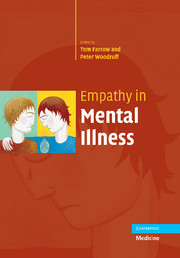Book contents
- Frontmatter
- Contents
- Foreword
- List of contributors
- Part I ‘Dysempathy’ in psychiatric samples
- Part II Empathy and related concepts in health
- 9 Neonatal antecedents for empathy
- 10 The evolutionary neurobiology, emergence and facilitation of empathy
- 11 Naturally occurring variability in state empathy
- 12 Neuroimaging of empathy
- 13 The neurophysiology of empathy
- 14 The cognitive neuropsychology of empathy
- 15 The genetics of empathy and its disorders
- 16 Empathogenic agents: their use, abuse, mechanism of action and addiction potential
- 17 Existential empathy: the intimacy of self and other
- 18 Empathizing and systemizing in males, females and autism: a test of the neural competition theory
- 19 Motivational-affective processing and the neural foundations of empathy
- 20 Face processing and empathy
- Part III Empathy models, regulation and measurement of empathy
- Index
17 - Existential empathy: the intimacy of self and other
from Part II - Empathy and related concepts in health
Published online by Cambridge University Press: 17 August 2009
- Frontmatter
- Contents
- Foreword
- List of contributors
- Part I ‘Dysempathy’ in psychiatric samples
- Part II Empathy and related concepts in health
- 9 Neonatal antecedents for empathy
- 10 The evolutionary neurobiology, emergence and facilitation of empathy
- 11 Naturally occurring variability in state empathy
- 12 Neuroimaging of empathy
- 13 The neurophysiology of empathy
- 14 The cognitive neuropsychology of empathy
- 15 The genetics of empathy and its disorders
- 16 Empathogenic agents: their use, abuse, mechanism of action and addiction potential
- 17 Existential empathy: the intimacy of self and other
- 18 Empathizing and systemizing in males, females and autism: a test of the neural competition theory
- 19 Motivational-affective processing and the neural foundations of empathy
- 20 Face processing and empathy
- Part III Empathy models, regulation and measurement of empathy
- Index
Summary
Imitation and empathy between self and other
Empathy is the ability to imagine oneself in another's place, and understand the other's feelings. The aspect of understanding the feelings of others critically defines empathy, as opposed to sympathy, in which one has a feeling corresponding to that which another feels. How does this understanding occur? Understanding is the ability to make sense of things. As such, it is often assumed that understanding is a mental ability. However, one of the background assumptions of the research I am going to discuss here is that understanding is not exclusively mental but is essentially corporeal as well. The other central aspect of the definition of empathy is that it requires a sense of self and a sense of the other. Without self-awareness and awareness of the other, one cannot ‘imagine oneself in another's place’. Thus, the foundational aspects of empathy are a sense of self, a sense of the other, and an embodied relational process between self and other. Such an embodied relational process between self and other can be easily identified in imitative behaviour. Imitation is a central component of non-verbal communication in pre-verbal toddlers. In fact, when dyads and triads of children of different ages interact in settings with two or three identical sets of attractive objects, imitation is the predominant form of interaction between 18 and 30 months of age (Nadel, 2002). The effect of setting is reduced in older children with verbal abilities.
- Type
- Chapter
- Information
- Empathy in Mental Illness , pp. 310 - 321Publisher: Cambridge University PressPrint publication year: 2007
- 4
- Cited by

